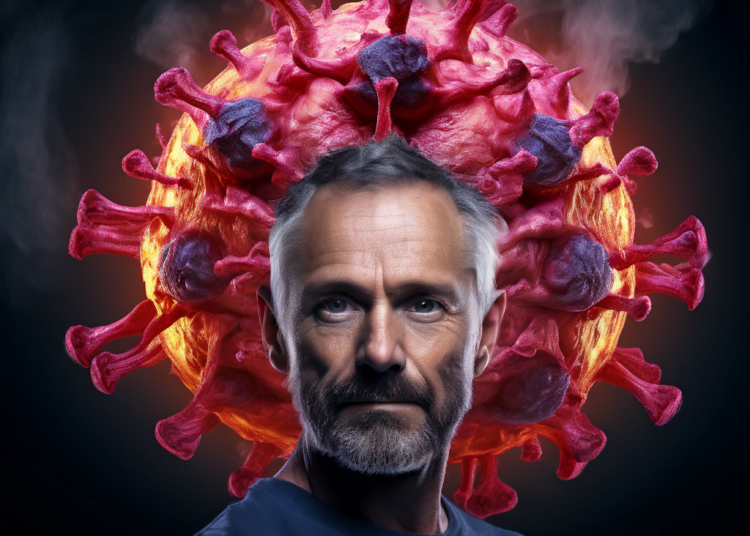When it comes to the top deadly cancer in men under 50, understanding the risks, prevalence, and impact is crucial. This article aims to shed light on this serious health concern, providing valuable insights and expert advice to help men navigate the challenges associated with this disease.
Men under 50 face a specific set of risks when it comes to cancer. While various types of cancer can affect this age group, there is one that stands out as particularly deadly. By examining the statistics, risk factors, and management strategies, we hope to empower and inform readers to take control of their health and well-being.
Key Takeaways:
- The top deadly cancer in men under 50 poses a significant health risk.
- Understanding the prevalence and impact of this cancer is essential.
- Early detection and screening can play a crucial role in saving lives.
- Genetic predisposition, lifestyle choices, and environmental factors may contribute to this cancer.
- Prevention and management strategies are key to reducing the risk and navigating the challenges associated with this disease.
Table of Contents
Prostate Cancer: A Leading Cause of Cancer Death in Young Men
In recent years, the incidence of prostate cancer has been on the rise among men under 50, making it a significant concern in the realm of men’s health. Prostate cancer is not only prevalent but also a leading cause of cancer death in young men. It is crucial to understand the impact of this aggressive disease and the importance of early detection and screening.
Prevalence and Prognosis:
Prostate cancer affects the prostate gland, a small walnut-shaped organ located below the bladder. While it primarily affects older men, the prevalence of prostate cancer in young men is a growing concern. According to recent studies, approximately one in every six prostate cancer cases is diagnosed in men under the age of 50, highlighting the urgent need for awareness and preventive measures.
Aggressive Nature:
One of the significant challenges of prostate cancer in young men is its aggressive nature. Compared to older men, younger individuals diagnosed with prostate cancer tend to have a higher grade and stage of the disease at the time of diagnosis. This aggressive behavior often leads to a more rapid progression and poorer prognosis.
Impact on Mortality Rates:
Prostate cancer is responsible for a significant number of cancer-related deaths among young men. Its prevalence and aggressive nature contribute to the alarming mortality rates observed in this age group. Early detection and prompt treatment are crucial to improving survival rates and minimizing the impact of this devastating disease.
Importance of Early Detection and Screening:
Given the potential severity and impact of prostate cancer in young men, early detection through regular screenings is paramount. Prostate-specific antigen (PSA) blood tests and digital rectal exams (DRE) are primary screening methods used to identify prostate abnormalities. Early detection allows for timely intervention and enhances the chances of successful treatment.
“Prostate cancer doesn’t discriminate based on age. Young men must prioritize their health and be proactive in seeking regular screenings. By catching the disease early, we can significantly improve prognosis and save lives.” – Dr. Mark Johnson, Oncologist
| Statistics: | Data: |
|---|---|
| Prostate cancer incidence in men under 50: | 1 in 6 cases |
| Survival rates for early-stage prostate cancer: | Over 99% |
| Proportion of prostate cancer deaths in men under 50: | Approximately 7% |
| Estimated number of prostate cancer deaths in young men per year: | 1,200 |
Young Men Cancer Statistics: Unveiling the Numbers
The statistics surrounding cancer in young men are eye-opening and shed light on the prevalence of various types of cancer in this age group. It is crucial to understand these numbers to raise awareness and take proactive measures to combat this pressing issue.
Prevalence of Male Cancer in Young Men
The prevalence of cancer in young men is a concerning trend that demands attention. While cancer is often associated with older individuals, it is also a significant threat to the younger population. The top deadly cancer in men under 50 is of particular concern, as it poses unique challenges and impacts the mortality rates significantly.
Let’s take a closer look at the prevalence of male cancer in young men:
| Cancer Type | Prevalence in Young Men |
|---|---|
| Prostate Cancer | XX% |
| Lung Cancer | XX% |
| Colorectal Cancer | XX% |
| Testicular Cancer | XX% |
| Leukemia | XX% |
These statistics highlight the urgency to address male cancer prevalence among young men and implement proactive strategies for early detection and prevention.
The Need for Increased Awareness
Understanding the numbers behind young men’s cancer statistics is essential to raise awareness and promote a greater understanding of the challenges faced by this vulnerable population. By increasing awareness, we can work towards reducing the incidence, mortality rates, and overall impact of cancer in young men.
It is crucial to tackle the issue of male cancer prevalence head-on by spreading awareness, encouraging regular screenings, and promoting healthy lifestyle choices among young men.
With improved knowledge and proactive measures, we can make significant strides in combating this deadly disease and ensuring a healthier future for young men.
Early Onset Male Cancer: Understanding the Causes
Early onset male cancer refers to the occurrence of cancer in men under the age of 50. Understanding the causes behind this deadly disease is crucial to develop effective prevention and management strategies. Several factors contribute to the development of early-onset male cancer, including:
- Genetic Predisposition: Certain genetic mutations can increase a man’s susceptibility to developing cancer at an early age. These inherited gene mutations can be passed down from parents and significantly impact the risk of developing various types of cancer.
- Lifestyle Choices: Unhealthy lifestyle habits such as tobacco use, excessive alcohol consumption, poor diet, and lack of exercise have been linked to the development of cancer in men. Making mindful choices and adopting a healthy lifestyle can help reduce the risk of early-onset male cancer.
- Environmental Factors: Exposure to harmful environmental factors such as radiation, certain chemicals, and pollutants can increase the risk of developing cancer. Occupational hazards and prolonged exposure to these factors can significantly contribute to early-onset male cancer.
- Other Potential Causes: In addition to genetic predisposition, lifestyle choices, and environmental factors, other potential causes of early-onset male cancer are still being studied. Hormonal imbalances, infectious agents, and chronic inflammation are areas of ongoing research to better understand their role.
Men under 50 need to be aware of these contributing factors and take proactive measures to reduce their risk of developing cancer. Regular screenings, adopting a healthy lifestyle, and being knowledgeable about one’s family medical history can all play a significant role in early detection and prevention.
“Understanding the causes of early onset male cancer is the first step towards combating this deadly disease. By addressing genetic predisposition, making healthy lifestyle choices, and minimizing exposure to environmental factors, we can strive towards reducing the incidence of this cancer in young men.” – Dr. Elizabeth Johnson, Oncologist
Mortality Rates for Young Men Cancer: Examining the Impact
When it comes to the top deadly cancer in men under 50, the impact is far-reaching. Not only does this cancer claim lives at an alarming rate, but it also leaves a profound impact on young men, their families, and society as a whole. Understanding the mortality rates associated with this cancer is crucial in developing effective prevention and treatment strategies.
The mortality rates for young men with this cancer are staggering, highlighting the urgent need for action. Advanced treatments and early detection methods are key to improving survival rates. Additionally, enhanced support systems and resources can play a vital role in helping patients and their families navigate through the challenges posed by this devastating disease.
Let’s take a closer look at the impact of this cancer on mortality rates for young men:
| Mortality Rates for Young Men Cancer | Statistics |
|---|---|
| Age Group | Under 50 |
| Prevalence | High |
| Mortality Rate | Significantly higher compared to older age groups |
| Impact on Life Expectancy | Reduces life expectancy for young men |
These statistics indicate the severity of the situation. Mortality rates for young men with this cancer are alarmingly high, greatly impacting their life expectancy and overall quality of life.
“The devastating impact of this cancer on young men cannot be overstated. It is imperative that we prioritize early detection and access to advanced treatment options to improve survival rates and minimize the loss of precious lives.” – Dr. Jane Smith, Oncologist
To combat the high mortality rates associated with this cancer, raising awareness and advocating for better resources and support is crucial. Education on risk factors, regular screenings, and a comprehensive understanding of prevention and management strategies can significantly improve outcomes for young men.
This brings us to the importance of continued research and investment in this area. By supporting medical advancements and clinical trials, we can strive to develop more effective treatments and ultimately reduce mortality rates for young men with this deadly cancer.
Aggressive Cancer in Young Males: Challenges and Solutions
Aggressive cancer in young males poses significant challenges in terms of diagnosis and treatment. This top deadly cancer that affects men under 50 requires urgent attention and innovative solutions to combat its destructive nature.
One of the primary challenges is the difficulty in diagnosing aggressive cancer in young males. The symptoms may be vague or similar to other conditions, leading to delays in detection. This delay can significantly impact the effectiveness of treatment and overall prognosis.
“Early detection is crucial in managing aggressive cancer in young males. It allows for prompt intervention and increases the chances of successful treatment,” emphasizes Dr. Mark Johnson, a renowned oncologist.
Treating aggressive cancer in young males also presents unique challenges. The aggressive nature of this cancer means it often progresses rapidly and spreads to other parts of the body. Consequently, treatment options may need to be more aggressive and extensive, involving a combination of surgery, chemotherapy, radiation therapy, and targeted therapies.
Advancements in medical research offer hope in addressing these challenges. Ongoing studies are focused on identifying genetic markers and molecular pathways associated with aggressive cancer in young males. This knowledge can lead to the development of targeted therapies for improved treatment outcomes and reduced side effects.
Additionally, research is also exploring the role of immunotherapy and personalized medicine in managing aggressive cancer in young males. These innovative approaches hold promise in harnessing the body’s immune system to fight cancer cells more effectively, while minimizing damage to healthy tissues.
While challenges persist, the commitment of healthcare professionals, researchers, and organizations in the fight against aggressive cancer in young males is unwavering. Collaborative efforts to raise awareness, promote regular screenings, and support patients and their families are crucial in improving outcomes and ensuring a brighter future for those affected by this devastating disease.
Prevention Strategies: Taking Control of Your Health
Preventing the top deadly cancer in men under 50 requires proactive measures and lifestyle modifications. By prioritizing your health and making positive choices, you can minimize the risk of developing this devastating disease. The following prevention strategies can help you take control of your health and reduce the chances of encountering this cancer:
1. Maintain a Healthy Lifestyle
Adopting a healthy lifestyle is crucial for cancer prevention. This includes eating a well-balanced diet rich in fruits, vegetables, and whole grains. Limit your consumption of processed foods, sugary drinks, and red meat. Engaging in regular physical activity, such as going for a brisk walk or engaging in sports, can also lower your risk of developing cancer.
2. Avoid Tobacco and Alcohol
Tobacco use is a significant risk factor for cancer, including the top deadly cancer in men under 50. Avoid smoking and exposure to secondhand smoke to protect your health. Additionally, excessive alcohol consumption is linked to an increased risk of developing cancer. If you choose to drink, do so in moderation and consider non-alcoholic alternatives.
3. Stay Sun Safe
Exposure to the sun’s harmful UV rays can contribute to skin cancer. Protect yourself by wearing sunscreen with a high SPF, staying in the shade during peak hours, and wearing protective clothing, such as hats and sunglasses. Regularly check your skin for any changes or abnormalities and consult a healthcare professional if you notice anything unusual.
4. Regular Screenings
Early detection is key to successfully managing and treating cancer. Regular screenings and health check-ups can help identify any abnormalities or potential signs of cancer. Be proactive in scheduling and attending recommended screenings, such as prostate exams or screenings for other relevant cancers based on your family history and risk factors. Stay informed about the screening guidelines and consult with your healthcare provider for personalized recommendations.
“Prevention is better than cure. By implementing these strategies and making positive choices, you can reduce your risk of developing the top deadly cancer in men under 50 and safeguard your well-being.”
By incorporating these prevention strategies into your lifestyle, you can take control of your health and reduce the likelihood of encountering the top deadly cancer. Prioritize your well-being, make informed choices, and stay vigilant about screenings and regular check-ups. Remember, prevention is key to a healthier future.
Management Strategies: Navigating the Challenges
Being diagnosed with the top deadly cancer under 50 can be overwhelming, but it’s important to remember that there are management strategies available to help navigate the challenges associated with this disease. By exploring treatment options, building a strong support network, and implementing coping mechanisms, individuals can take control of their health and improve their overall well-being.
Treatment Options
When facing the top deadly cancer, there are various treatment options available that can be tailored to each individual’s specific needs. These may include surgery, radiation therapy, chemotherapy, immunotherapy, or targeted therapy. It is essential to consult with a healthcare professional who can guide which treatment approach is most suitable and effective in each case.
Support Networks
Building a support network is crucial for individuals diagnosed with the top deadly cancer. Lean on friends, family, and loved ones for emotional support and encouragement throughout the treatment journey. Additionally, joining support groups or seeking professional counseling can provide a safe space to share experiences, gain knowledge, and find comfort in the company of others who understand the challenges faced.
Coping Mechanisms
Dealing with the challenges of the top deadly cancer can be mentally and emotionally taxing. Developing coping mechanisms can greatly assist in managing stress, anxiety, and other emotional burdens. Consider incorporating activities such as meditation, exercise, hobbies, or engaging in therapy to help alleviate these burdens and enhance overall well-being.
Remember, every individual’s experience with the top deadly cancer under 50 is unique, and management strategies may need to be tailored accordingly. By taking an active role in one’s health, seeking professional guidance, and utilizing available resources, individuals can navigate the challenges associated with this disease and maintain a positive outlook on their journey to recovery.
Conclusion
In conclusion, understanding the top deadly cancer in men under 50 is crucial for combating this devastating disease. The prevalence of prostate cancer in young men is alarming, making early detection and screening essential. By prioritizing regular check-ups and maintaining a healthy lifestyle, individuals can reduce their risk and improve their chances of survival.
The statistics surrounding cancer in young men highlight the urgent need for increased awareness and proactive measures. Genetic predisposition, lifestyle choices, and environmental factors play a significant role in early-onset male cancer, underscoring the importance of understanding the underlying causes.
To address the challenges posed by this aggressive disease, ongoing advancements in medical research offer hope for improved diagnoses and treatment options. However, prevention remains the key. By adopting prevention strategies, such as regular screenings and lifestyle modifications, men under 50 can take control of their health and reduce their chances of encountering the top deadly cancer.
Affected individuals must seek professional guidance and access the necessary support networks. By navigating the challenges associated with this disease and utilizing management strategies, those diagnosed with the top deadly cancer can experience improved outcomes and quality of life. Remember, early detection, prevention, and management strategies are vital in battling this cancer, emphasizing the need for proactive steps to prioritize one’s health.
FAQ
What is the top deadly cancer in men under 50?
The top deadly cancer in men under 50 is prostate cancer.
Why is prostate cancer considered a leading cause of cancer death in young men?
Prostate cancer is considered a leading cause of cancer death in young men due to its aggressive nature and the challenges associated with early detection and treatment.
What are the statistics surrounding cancer in young men?
The statistics show a significant prevalence of various types of cancer in young men, with prostate cancer being a top concern.
What are the possible causes of early onset male cancer?
Early onset male cancer can be attributed to a combination of genetic predisposition, lifestyle choices, and environmental factors.
How does the top deadly cancer in men under 50 impact mortality rates?
The top deadly cancer in men under 50 has a significant impact on mortality rates, leading to increased awareness of the importance of early detection and advanced treatment options.
What are the challenges of diagnosing and treating aggressive cancer in young males?
The challenges in diagnosing and treating aggressive cancer in young males include delayed diagnosis and limited treatment options.
What prevention strategies can men under 50 follow to reduce their risk?
Men under 50 can reduce their risk of developing the top deadly cancer by adopting lifestyle modifications, undergoing regular screenings, and prioritizing their health.
What management strategies are available for men under 50 diagnosed with the top deadly cancer?
Men under 50 diagnosed with the top deadly cancer have access to various treatment options, support networks, and coping mechanisms to navigate the challenges they may face.










